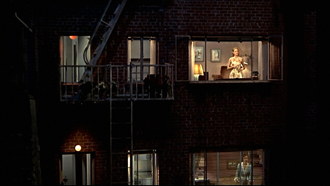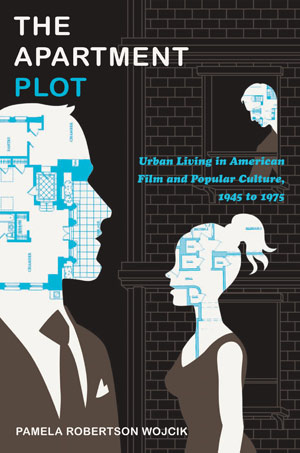
The Apartment Plot argues for the dominance and centrality of the apartment plot from 1945 to 1975.
What I am calling “the apartment plot” are narratives in which the apartment figures as a central device. This means that the apartment is not only setting, but motivates or shapes the narrative in some key way.
The apartment plot dominates romantic comedy of the period, but also appears in film noir, musicals, and melodrama. The apartment is present in plays, novels, self-help books and comic strips. Most, but not all, examples of the apartment plot are set in New York.
Rather than an incidental setting, this book argues that the apartment functions as a particularly privileged site for representing an important alternative to dominant discourses of and about the fifties in America. The apartment plot offers a vision of home, centered on values of visibility, contact, density, mobility, impermanence, permeability, spontaneity, and porousness that contrasts sharply with more traditional views of home as private, stable, and family-based.
I argue that the apartment plot emerges so strongly in the postwar period because the meaning and status of urban living is undergoing a sea change related to urban sprawl, blight, white flight and urban renewal. The apartment plot provides a counterpoint to the suburban ideal, for good or bad, but also mobilizes a host of themes that articulate, in their own right, ideas that are at the heart of contemporary debates about the status of the city.
This book is neither a history of apartments, nor about architecture. Instead, it is about urban fantasy, or what I call a philosophy of urbanism. It is about the apartment as an imagined space, and a genre. It is about the way in which representing the apartment, in film, novels, comic strips and more, functions as a way of imagining the urban, and of imagining identities as produced and shaped by the urban.
At the same time, however, the apartment is always described in relation to historical discourses—discourses on family, gender, sex, race, class, space, urbanism—that shape the philosophy of urbanism and the apartment as urban habitat.
“The apartment plot offers a vision of home, centered on values of visibility, contact, density, mobility, impermanence, permeability, spontaneity, and porousness that contrasts sharply with more traditional views of home as private, stable, and family-based.”
The book addresses a few different fields of inquiry. These include film genre, and writing on genre by people like Rick Altman. They also include ideas about urbanism. I focus especially on two texts, Jane Jacobs’s 1961 book The Death and Life of Great American Cities and Henri Lefebvre’s Right to the City from 1968.
I focus on Jacobs, an urban planner, to emphasize the currency in mid-century thought of ideals of porousness, density, community, and public life that her work signals. These ideals run counter to dominant notions of containment that have colored so many of our perceptions of the fifties and beyond. The apartment plot navigates the tensions between privacy and community, loneliness and density, contact and entanglement that Jacobs describes. The unique qualities Jacobs attributes to the city are, I argue, animated in the apartment plot, not simply as an external feature of public city life but situated inside the apartment unit and building.
My understanding of urbanism as a philosophy stems also from my reading of the French philosopher and theorist of space Lefebvre. In analyzing the concrete problems of the city in mid-century, Lefebvre arrives at a philosophy of the urban, a conception of its ideal form. Something of a utopian ideal, the urban figures in his writing, nonetheless, as a right, and a possibility. Describing the right to the city as a right which defines civilization, Lefebvre characterizes it as “the right to urban life, to renewed centrality, to places of encounter and exchange, to life rhythms and time uses, enabling the full and complete usage of these moments and places.”
This interest in urbanism represents something of a shift in my work.
My first book, Guilty Pleasures, examined what I called feminist camp as both a performance practice and a mode of spectatorship. I was interested in countering the notion of the passive or victimized female spectator, subject to her own oppression in images. I was also interested in seeking affinities and alliances between queer and straight and gay male and female cultures as a strategic move for identity politics.
Much of my other work has been engaged by issues of performance; I edited a collection titled Movie Acting. And I edited a collection of essays on popular music in film called Soundtrack Available. What links these works, I think, is my interest in looking at aspects of film that have been somewhat neglected, and film’s relation to other arts, such as popular music and theater. My perspective on those things is always informed by issues related to ideology, and especially gender.
The Apartment Plot began initially as a book on genre. Watching That Funny Feeling one day, I was struck by its similarity to Pillow Talk. I began thinking about many different kinds of apartment plots—Breakfast at Tiffany’s, Rear Window, Wait Until Dark, Klute, and Boys in the Band—and started seeing links between them.
But as I began looking into the films, I became aware of how much this dominant strand of film and popular culture had been ignored or denied by the dominant reading of the period. Most accounts of the fifties assume not only that everybody moved to the suburbs, but also that entertainment shifted its focus to the suburbs as well. Again and again, I would read that the housewife was the dominant image of women, the suburban breadwinner the dominant male, and that all movies and TV shows looked like Leave It to Beaver.
The films pointed in a different direction—an urban fifties. They also pointed toward a burgeoning singles culture. Against the typical stereotype of the mandate for early marriage in the fifties, they served as a reminder that this was also the era of Playboy magazine, Sex and the Single Girl, and queer urban pulp fiction.
So, I not only examined the films as a genre, locating formal and thematic affinities among them, but also started to look at them as documenting an urban reality, on the one hand, and urban fantasy, on the other, both reflecting the urban and imagining it.
I also started thinking about the differences among urban experience for single men vs. single women, gay people vs. straight, married vs. single, and black vs. white. So, rather than organize the chapters around subgenres—such as the musical, thriller, romance, etc.—I decided to organize them by “tenant”—bachelors, single girls, young marrieds, and African Americans.

The chapter on the bachelor, “We Like our Apartment: The Playboy Indoors” offers readers a fun way into the book. Much of it deals with the way in which Playboy magazine figures the apartment as a space of seduction, through cartoons, editorials, articles, and pictorials. It deals with such famous bachelor pads as the ones in Pillow Talk and That Funny Feeling and describes the way in which the playboy identity is produced in and through the apartment in films like Boys Night Out, The Tender Trap, Come Blow Your Horn, and The Apartment.
The chapter also takes up the way in which male roommates are rendered queer and/or problematic in The Odd Couple, Artists and Models, and Rope, and the affinity between the straight bachelor pad and the gay apartment in Boys in the Band. These films articulate a model of masculinity that is uniquely urban, and curiously domestic. At the same time, they represent this indoors masculinity as under constant pressure, vulnerable to intrusion, and marked by feminine and queer influences. In different ways, they each posit a model of masculine identity that is tenuous, contingent, and mobile.
“Movin’ On Up: the African American Apartment” presents a different angle on the genre. I suggest that the philosophy of urbanism activated within the apartment plot whitewashes the city to represent urbanism as a privilege accorded whites, isolated from the realities of the city’s racial and class dynamics.
In this sense, the apartment plot not only participates in a project of imagining the urban in the context of mid-century urban renewal, but enacts a process of urban renewal at the level of representation. As it does so, it also participates in the process James Baldwin identified as “Negro removal,” since urban renewal so often depends upon eliminating black neighborhoods and populations from sight.
Texts such as The Jeffersons, Claudine, A Patch of Blue, and The Landlord, attend to the ways in which black urban populations have been systematically denied access to the life chances afforded white middle class urban populations, and present a critique of the status quo. They insist on what Lefebvre terms “the right to the city” as a possibility that should be available to all.
“Rather than organize the chapters around subgenres—such as the musical, thriller, romance, etc.—I decided to organize them by ‘tenant’—bachelors, single girls, young marrieds, and African Americans.”
The Apartment Plot should help revise the dominant view of the 1950s as homogenous, suburban, white, heterosexual, marriage-obsessed, and contained.
I would hope the book might also convince people to consider this wide-ranging group of films as a genre, while recognizing the fluidity of the apartment plot, its ability to absorb and reframe new ideas about the city.
I would also hope that others would examine the apartment plot in different contexts, different nations. Sharon Marcus has written about apartment stories in British and French nineteenth century novels. Perhaps someone will write about Polish or French apartment plots in film.
And I’d like to spur conversation about the meanings of the urban—how we view the urban, what counts among urban experience, and what philosophy of urbanism motivates us—and about the importance of space—in terms of genre, certainly, but also in terms of how space shapes identity, opportunity, and experience.
As much as anything, I hope The Apartment Plot will make you watch some of the movies and novels I write about—and engage the urban fantasy.


Pamela Robertson Wojcik is Professor in the Department of Film, TV and Theatre at the University of Notre Dame. She is President-Elect of the Society for Cinema and Media Studies. Besides Fantasies of Neglect: Imagining the Urban Child in American Film and Fiction, she is author of The Apartment Plot: Urban Living in American Film and Fiction, 1945 to 1975, featured in a previous Rorotoko interview, Guilty Pleasures: Feminist Camp from Mae West to Madonna, co-editor of Soundtrack Available: Essays on Film and Popular Music, and editor of Movie Acting: The Film Reader and New Constellations: Movie Stars of the 1960s.